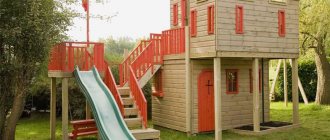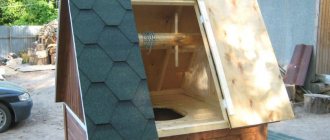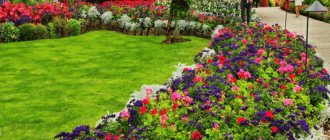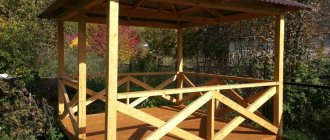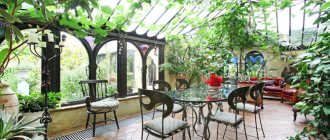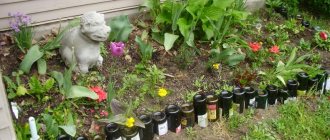What is a mixborder
A mixborder is a flower garden, the characteristic feature of which is the stepped planting of plants. Its dimensions can be any, but you must adhere to the rule: the width must be at least 2 times less than the length. As for the choice of flowers, their flowering should alternate. For example, in the spring a flowerbed can delight with primroses, in the summer with lilies and roses, in the fall with chrysanthemums and asters.
In addition, you should know that in each flower garden you can select several plants that serve as the basis. It is with them that you need to start when developing a mixborder scheme. Using a diagram will help you properly organize the decorative area.
Nowadays, mixborders are diluted with statues, large boulders, gratings, screens, and arches. Here you need to be guided by a sense of proportion so that, in the pursuit of originality, you do not turn an interesting decor into an absurd structure.
In the hands of specialists, this type of flower garden is a powerful weapon for transforming a typical plot into a paradise oasis. Yes, it will not be easy and expensive, but the opportunity to delight the eye with an ocean of flowers in the yard all year round is worth it.
How to set the rhythm of a flower garden
At first glance, a mixed border filled with colorful flowers looks very impressive, but the structure is more important than the color scheme. Without this, any mixborder will look sloppy, especially after your flowers fade. Plants must be selected according to height, and here you need to take into account the size and proportions of the mixborder and your garden. Small perennials are suitable for a small mixborder, but trees and shrubs can be confidently planted in a mixborder in a large garden. The further from the front edge of the mixborder, the taller the plants should be, while, for variety, you can plant several tall ones in front, but slender ones, not massive ones.
Experienced gardeners have a concept called “plant as an upstart.” This technique works well when you need to set a rhythm in a flower garden.
NatalijaG FORUMHOUSE participant
The division by height is often violated in model pictures, and in the first row, next to the ground covers, rather tall lilies or speedwells or loosestrife appear. Of course, at the back they are lined with something even taller, but there is no clear division between high-medium-low, and this just gives the flower garden a natural look.
In every plot there is a “genius loci,” a tuning fork that sets the tone for everything else and dictates what to plant and what not. This is usually the tallest, most visible tree, often a conifer. Therefore, if you feel that you will end up with conifers anyway, plant them as early as possible - they take a long time to grow. And add junipers and thujas to them - but, of course, if the area of your plot is at least 10 acres.
As a rule, perennials and shrubs cannot boast of expressiveness, so it is recommended to include strict geometric shapes in the mixborder: spherical, creeping, spherical, tall and narrow columnar, openwork or cubic, which is achieved by cutting.
Massive plants can be balanced with cereals - the mixborder will become lighter and airier. A large bush looks disproportionate next to a small single plant, but several small plants next to the same large bush are already a balanced composition.
Kinds
The photo of mixborders shows that they can be one- or two-sided. In the first case, tall plants are planted in the background, and then medium- and low-growing ones. In the second option, tall flowers are placed along the middle line of the future flower bed, and then the height of the plantings is gradually reduced.
The difference between the two mixborders may lie in the filling. Perennial and annual flowers, dwarf trees, shrubs, herbs - all this can be used in decoration.
A do-it-yourself mixborder can easily fit into a garden of any design, since it can be created in different styles:
- In English. Considered a classic. Distinctive features are severity, lack of curvaceous shapes and bright accents, and an abundance of pastel shades. Recommended filling: small roses and anemones.
- In Meadow. Reminiscent of a natural meadow. Flowers – field daisies, bells, poppies, carnations. It is appropriate to use cereal crops.
- In a rustic way. Ready-made mixborders of this type are colorful and romantic. They are usually preferred by connoisseurs of Provence. Plants used: sunflowers, mallow, heather, lupine.
There are also mixborders:
- Shadow. Plantings that thrive in partial shade are selected. The flowerbed turns out to be laconic and discreet, with small flowers and beautiful shrubs.
- Continuous flowering. Requires allocation of a large area. Filled with plants participating in the flowering relay throughout the season.
Understanding the concepts
First of all, let’s clarify what a mixborder is. Literally translated from English it turns out to be “mixed border”. This is a flower garden of arbitrary oblong shape, consisting of various plants collected in fairly dense groups.
Mixborder is a “relative” of rabatka, and often these two flower beds are confused with each other. A ridge is also an oblong flower bed (bed), which is easy to make with your own hands. It is distinguished by the strictness of its lines, both in shape and design; it can be strictly rectangular; even the turns of a long ridge are made at the correct angles. The floral pattern must also be strictly defined (lines, circles, stars, triangles, etc.). Mixborder differs from rabatka by smooth and soft lines. This is already a representative of the landscape style; irregular shapes and a freer use of different types of plants are acceptable here.
Landscape designers use mixborders to design slopes and entrance areas, decorate fences, garden paths, and divide the garden into sectors.
Mixborder with roses
If you are planning to create a mixborder with roses, they should occupy a dominant position. The rest of the plants are planted around them.
The placement of roses can be dotted or a solid line. In the first case, they are alternated with contrasting low perennials. Any shrub forms are selected for the background.
Mixborder of perennials
Mixborders made from perennials are another unusual solution. First you need to decide on the configuration of the composition and dimensions. Then it’s worth choosing the base plants. It can be:
- elder;
- hydrangea;
- jasmine;
- hibiscus.
As soon as the central part of the flower garden is arranged, you can begin planting the middle row. Recommended flowers are asters, phlox, wormwood, geranium, etc. The foreground should be filled with low-growing plants.
Advice from experienced flower growers
To create a mixborder of perennial flowers that bloom at the same time, ground cover roses are suitable. You can alternate them with fills or, for example, perennials that give a clear outline - for example, hostas or daylilies. But they all grow and will still have to be dug up and divided every 3-4 years (except for roses). You can combine roses, for example, with spherical thujas (small ones, for example Danika).
LEKA77
https://www.forumhouse.ru/threads/42603/page-2
Perennials are good because they can grow for a long time in one place, but at the same time their flowering period is short. Among perennials, I prefer plants that do not lose their decorative qualities after flowering in our heat, therefore: roses, lavender, daylilies, daisies, under trees - hostas, astilbes, bergenia, ferns, heucheras.
Kiti
https://www.forumhouse.ru/threads/42603/
Derain, spirea (gray, with a white waterfall), lilac (also white), hydrangeas go well together). They do not require any special soil conditions; the slightly acidic reaction of the soil environment will suit everyone, and details can be adjusted during planting and further care. Nobody likes getting wet and buried, this needs to be taken into account. If you are looking for easy ways, then give up shrubs that are obviously unstable in our climate (unstable wintering and irregular flowering). Be sure to consider the plant’s relationship to light, this is important.
Chigs
https://www.forumhouse.ru/threads/42603/page-2
Mixborder of conifers and shrubs
Shrub and conifer mixborders are a standard example of plant use. Similar flower beds are placed in various places:
- near utility buildings;
- along the fence of the site;
- along the front of the house.
The conifers play the role of a skeleton - they determine the height and outline of the flowerbed. They are placed in the background, and only when the composition is created in a free area are they given a central place.
The mixborder of shrubs usually consists of lilac, magnolia, hibiscus, and elderberry. They are diluted with dwarf trees, cereals, and small flowers.
Site preparation
Preparatory work begins in the fall. They clean the area for the mixborder, dig up the soil, and at the same time apply complex mineral macro and microfertilizers: nitrogen, potassium, phosphorus, zinc, copper.
The clods of earth are not broken so that they may collapse under the influence of frost; the earth has become looser and allows water and air to pass through well.
Step-by-step instructions (guide)
The main preparation is carried out 2-3 weeks before planting the seedlings. To begin with, mark the front line of the flowerbed, and embed plastic border strips 30-40 cm wide along it. The border should rise 5-10 cm above the ground surface.
- Organic matter is laid out on the surface: manure, peat, compost. If necessary, sprinkle dolomite flour to reduce the acidity of the soil. The soil is dug up again, the area is harrowed with a rake, and leveled.
- Mark places for trees according to the diagrams. Plastic borders are used for this. They are necessary so that the root systems of fast-growing crops do not grow, intertwine with each other, and do not interfere with the development of “neighbors.” However, each crop needs to be left enough space in the flowerbed for its own development. Empty spaces can be filled with creeping plants or annuals.
- Dwarf coniferous trees and small shrubs are planted first.
- Then, with the same plastic tapes, places for perennials are allocated; their width can be smaller, no more than 15-20 cm.
- Dig holes or trenches for planting perennial herbaceous crops and flowers. Fill them with water, and a day later the seedlings are planted according to the chosen scheme. Cover with earth and lightly compact.
- Cover the entire area with compost with a layer of 2-3 cm, then mulch with crushed tree bark, small cones, and pebbles.
Advice
If the place chosen for the mixborder is located close to the country house, you cannot plant a lot of honey-bearing flowers on it. They will attract bees and wasps, this situation increases the risk of them attacking humans.
Selection of ornamental crops
Mixed flower beds are attracting more and more gardeners in Russia.
They are not difficult to arrange, the crops here are unpretentious, they decorate the garden for many years without causing much trouble. If you choose the right crops for the flower garden from the very beginning, then caring for the flower garden will be the easiest, without any problems.
- Coniferous crops and ornamental shrubs should be selected from dwarf species, no higher than one and a half meters. Pine, fir, spruce, thuja, and juniper will fit well here.
- To dilute the green tone, you can add bushes of rhododendrons and barberries. During the flowering period, heather will perfectly decorate a flower garden with crimson flower lights.
- The background of the flower garden is filled with tall “skeletal” plants: dahlias, hydrangeas, delphiniums, astilbe. Bushes of jasmine, red-leaved plum or park roses will dominate the background of these beautiful flowering crops.
- The middle place is reserved for perennial herbs and flowers: yellow daylilies, frintillaria, phlox, pennisetums.
- The foreground, open for viewing, is occupied by unpretentious low plants: geraniums, heucheras, petunias, cineraria. If the mixborder is created in a folk style, low-growing cereals can be planted here: sedge, feather grass, haretail, pearl barley.
- To decorate flower beds in a garden (vegetable) style, “beautiful” vegetables are selected: bright lettuce leaves, parsley, herbs with lacy leaves, decorative cabbage. The border for such a bed is made of bright flowers: calendula, petunias, tagetes.
It is not difficult to care for mixed flower beds; every spring the outline of the flower bed is corrected, some plants are added, some plants are removed, and annuals are planted.
Selecting a location
When deciding where to organize a mixborder, it is worth considering that it does not accept damp, shaded places. Open space is also not suitable for it - direct sunlight will harm the plants.
It is advisable to allocate a semi-shaded area for the flower garden near the fence or near the house. A flower bed laid out along the perimeter of the terrace or along the garden path looks interesting.
In general, it is best to develop a project for the future decorative zone. If you plan to place a mixborder under the windows, then you need to think through everything so that the flowers do not interfere with the lighting of the room. When choosing an option near the path, you need to step back 0.5 m.
It is possible to advantageously arrange a complex flower bed around the perimeter provided that plants are planted intermittently. When developing a diagram, it is worth avoiding straight lines whenever possible. The wavy border should serve as a guide. Moreover, the greater the number of waves, the more beautiful the mixborder looks.
Color harmony
It is necessary to ensure that the tonality of the leaves of perennial herbaceous plants and the petals of flowering crops is in harmony with each other in the mixborder. It is necessary to determine in advance the entire spectrum of the future composition, indicate on the diagram where this or that decorative element will be planted.
Care
Despite the chosen design of the mixborder, when creating it you need to abandon overly aggressive plantings, as well as plants that are prone to rapid growth. Each seedling should be planted at a certain distance from each other - this will make it easier to water and weed.
It is recommended to provide stone details or small areas in the center of the mixborder. They can be used to provide easier access to plants during weeding and pruning. It is advisable to arrange a narrow path on the back side of the flower bed.
Mixborder is a beautiful thing, but difficult to care for. Therefore, it is important to study information about its structure and contents in advance. To make caring for a flower garden easier, experts advise choosing flowers and shrubs with the same requirements for soil, watering, and fertilizers.
Ecology of the place
It is necessary to study the environmental conditions of the site. Lighting, groundwater level and soil type will primarily determine the range of plants for the mixborder being created. It is most rational to focus on existing conditions and select plants specifically for them. Plants will never look good in the wrong conditions. It is impossible to make peonies bloom magnificently in the shade of trees, and it is just as difficult to get long-lasting and rich flowering of astilbe in an open sunny place. And thickets of solidago, monard, rudbeckia, catnip stand well only in open sunny places on poorly fertile soils and create a wonderful flower spot due to their healthy appearance and excellent condition.
The above, of course, does not mean that the existing conditions on the site do not need to be improved, but everything should be within reasonable limits. It is useless to radically change the ecology of a site, trying to adapt it to your fixed idea. It is useless to create a wetland on sand or a Mediterranean landscape under the crowns of spruce and birch trees. You will spend a lot of time, money and effort to create conditions that are alien to your site, but nature will ultimately win - gradually the plants will develop worse and worse, and you will have to spend more and more time caring for them.



